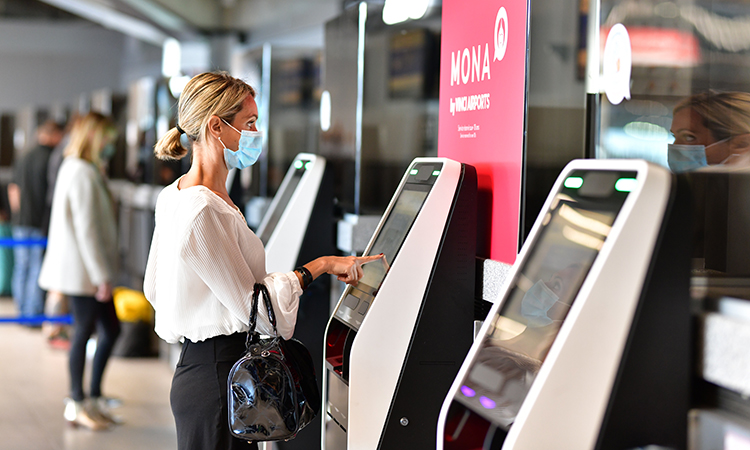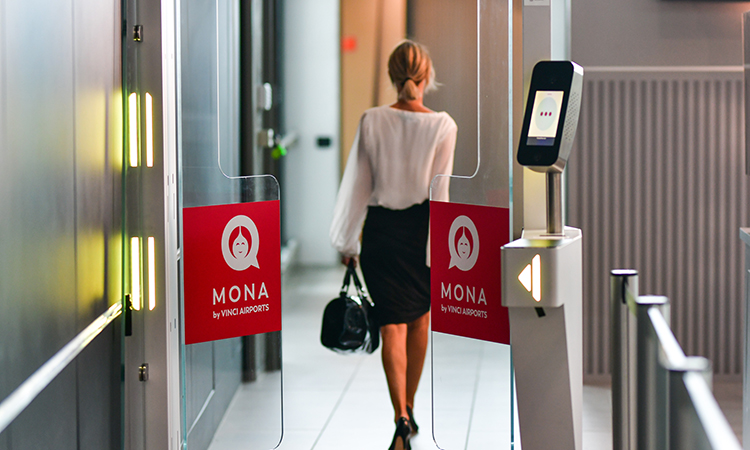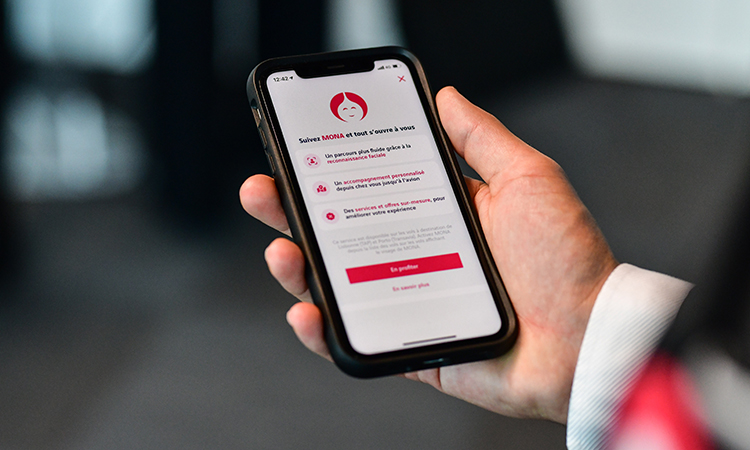Meet MONA, VINCI Airports’ revolutionary end-to-end biometric assistant
- Like
- Digg
- Del
- Tumblr
- VKontakte
- Buffer
- Love This
- Odnoklassniki
- Meneame
- Blogger
- Amazon
- Yahoo Mail
- Gmail
- AOL
- Newsvine
- HackerNews
- Evernote
- MySpace
- Mail.ru
- Viadeo
- Line
- Comments
- Yummly
- SMS
- Viber
- Telegram
- Subscribe
- Skype
- Facebook Messenger
- Kakao
- LiveJournal
- Yammer
- Edgar
- Fintel
- Mix
- Instapaper
- Copy Link
Posted: 22 April 2021 | VINCI Airports | No comments yet
VINCI Airports talks to International Airport Review about ‘MONA’, a revolutionary digital service and the first travel companion based on facial recognition, which was launched at France’s Lyon-Saint Exupéry Airport in October 2020.


Credit: VINCI Airports
This brand-new system is a major step towards the mobility of tomorrow and makes VINCI Airports the first airport operator in the world to allow its passengers to experience a biometric journey through a mobile-controlled Digital Identity for free”
The promise of MONA is to significantly transform the traveller experience from home, to airplane, and back again. This brand-new system is a major step towards the mobility of tomorrow and makes VINCI Airports the first airport operator in the world to allow its passengers to experience a biometric journey through a mobile-controlled Digital Identity for free. Although other biometric solutions do exist throughout the world, these are rarely available at each step of a passenger’s journey. Furthermore, the possibility for travellers to create their biometric account directly from their smartphone is an unprecedented VINCI Airports innovation.
Thanks to facial recognition and a specific route within the airport, MONA subscribers cross various airport control points – border control currently remains the only exception – by simply showing their face. Being an entirely contactless service, MONA is even more useful in the context of the COVID-19 pandemic.
A 30-minute time-saver for travellers
MONA was born after we, at VINCI Airports, observed that passengers often feel travelling by plane is a source of stress due to the many security controls and everlasting queues. We decided to respond to this issue through the creation of a new process utilising innovative technology that would allow for an easier, more fluid and relaxed travel experience.
The first travellers to experience MONA did so on 5 October 2020 at Lyon-Saint Exupéry Airport (LYS), one of VINCI Airports’ innovation centres. To benefit from this new service, travellers simply need to create their “Digital Identity” via their MONA App that connects their photograph, identity documents and boarding pass. This can be done from the comfort of home via a smartphone application. Passengers can also participate on a dedicated terminal at the airport.
Travellers simply need to create their “Digital Identity” via their MONA App that connects their photograph, identity documents and boarding pass”
In addition to the 30-minute time saving that MONA gives its users, it provides them with real-time flight and passenger route information, as well as personalised services and experiences, developed in partnership with airlines and airport businesses. The end-to-end travel assistance (upstream advice, reservation of services and geolocation in the airport) offered by the application is indeed an important factor in simplifying the journey and, therefore, in saving additional time. Thanks to MONA, customers gain in simplicity and ease.
The service was first made available at Lyon-Saint Exupéry Airport for Transavia (flights to Porto) and TAP Air Portugal (flights to Lisbon) passengers. VINCI Airports chose these Lyon-Portugal air links as the first to experiment MONA because of our operator role in each country. By implementing MONA for Lyon-Portugal travellers, we also want to support Portugal and France in the process of recovering their travel partnership in the future.


Credit: VINCI Airports
Data privacy and security at heart
Although MONA is available for some specific passengers at Lyon-Saint Exupéry Airport, its services are opt-in and not mandatory. The service only collects users’ personal data if they consent to it. The passenger’s identity and personal data is then stored in the secure container of the application. This data is, therefore, not accessible outside of the application and is encrypted as soon as passengers lock their smartphones. The passenger remains in control of his or her own data.
In order to maximise the traveller’s security, personal data is only used and sent to the biometric partner when loading the identity data and the boarding pass into the application in order to create the passenger’s biometric ‘template’ for their flight and enable facial recognition at the airport. This template is stored securely on Lyon‑Saint Exupéry Airport’s local database. It will be instantly deleted as soon as the customer’s aircraft leaves the parking stand to take-off, or if the flight is cancelled. In addition, the customer can delete their biometric identity data at any time, directly from the application. They will then have to recreate their Digital Identity if they wish to use MONA services for a future flight.
Recognising the need to ensure the privacy of passengers’ data, the team actively worked with the appropriated authorities. MONA has been submitted to the CNIL’s (French Data Protection Authority) review and benefitted from its latest recommendations regarding passengers’ data protection and rights. During the elaboration process, the team also worked closely with the DGAC (French General Directorate of Civil Aviation), as part of the ‘Safety Vision 2’ innovation programme led by this administration – which aims to promote safety innovation in order to strengthen its efficiency and improve its operators’ competitiveness.
VINCI Airports remains committed to the ethical and responsible facilitation of personal data within the airport processes.
100 per cent contactless
Most importantly, with MONA being 100 per cent contactless, it constitutes a privileged tool in times of the pandemic. Once users have registered their data in the application, getting their personal documents out in case of control is no longer necessary. The only formality required from passengers is showing their faces. As a result, overall contact with the airport’s staff and among passengers is noticeably reduced, from luggage check-in, to boarding the aircraft.
For example, MONA users can check-in their luggage in complete autonomy thanks to the dedicated automatic terminals. Instead of exchanging documents with an agent – which is not optimal in times of the pandemic – the user will only need to lower his mask for a few seconds in order to be recognised by the camera. Thus, benefitting both the passenger and the agent.
Moreover, this new technology no longer requires the traveller to take his phone, boarding pass or passport out, as every verification is done by biometrics. Passengers thus limit their risk of exposure to viruses by reducing the number of items they have to handle in a crowded place like the airport. Furthermore, since passengers spend far less time in queues with facial recognition, they have less proximity with other travellers.


Credit: VINCI Airports
An illustration of VINCI Airports’ culture of innovation
MONA offers a breakthrough experience that takes the airport experience to a completely new dimension. By developing a world-first in the biometric field, we at VINCI Airports show once again that innovation is at the heart of our business model. In 2019, VINCI Airports introduced another worldwide premiere in airports with the valet parking robot system, a technology that helps travellers to save time whilst reducing the airport’s environmental impact. Again, in 2020, VINCI Airports also put a particular emphasis on adapting airports to the fight against COVID-19. At Lisbon Airport (LIS), the deployment of the ‘Protecting each other’ campaign, as well as many innovations in response to the pandemic – like UV disinfection – played a key role in Lisbon Airport winning the Airports Council International (ACI) Europe Best Airport prize for the first time in its history.
With 45 airports in 12 countries, and three centres of excellence for innovation at London Gatwick Airport (LGW), Lisbon Airport and Lyon Airport, VINCI Airports’ innovation strategy benefits from our global presence and the diversity of the platforms we operate.
In the era of ‘no contact’ and personalisation, MONA proves VINCI Airports’ ability to reinvent itself constantly and focus its activities according to its customers’ needs, even in the most challenging time for the airport industry.
VINCI Airports, the leading private airport operator in the world, manages 45 airports in 12 countries in Europe, Asia and the Americas. We harness our expertise as a comprehensive integrator to develop, finance, build and operate airports, while leveraging our investment capability and expertise in optimising operational performance, modernising infrastructure and driving environmental transition. VINCI Airports became the first airport operator to start rolling out an international environmental strategy in 2016, with a view to achieving net zero emissions throughout its network by 2050.
Issue
Related topics
Airside operations, Apps, Biometrics, Contactless / Touchless technology, COVID-19, New technologies, Passenger experience and seamless travel, Self-service, Terminal operations
Related airports
Lisbon Airport (LIS), London Gatwick Airport (LGW), Lyon Saint-Exupéry Airport (LYS)
Related airlines
Related organisations
Airports Council International Europe (ACI Europe), French Civil Aviation Authority (DGAC), French Data Protection Authority (CNIL), VINCI Airports


















